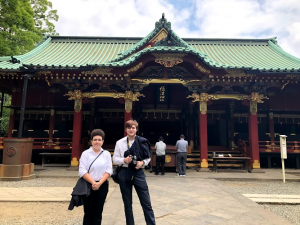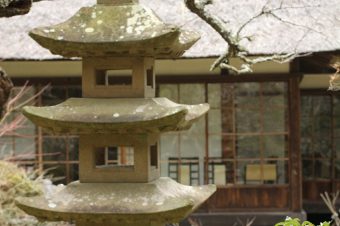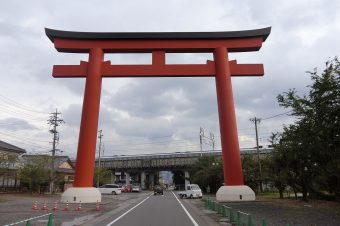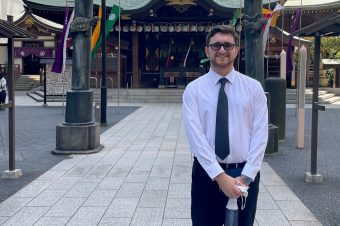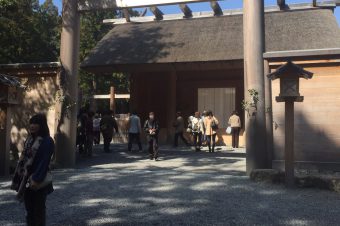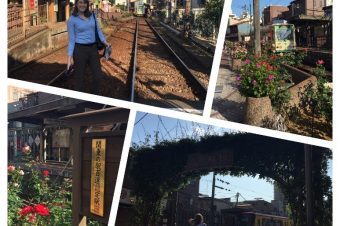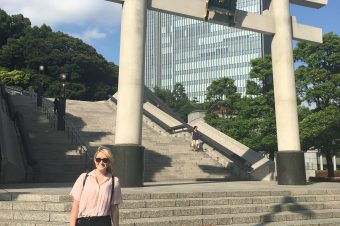The same day that we visited the Tenryuin and participated in the zazen lesson, we also made a few side trips around Yanaka Town. The day was the right mix of cloudy and sunny, where it was warm enough to work up a sweat, but the clouds kept the Sun from burning us to a crisp.
We gathered around the map of the town found just outside the Nezu Station exit and tried to plan where to visit first before we made our way to the Tenryuin. Our attention was grabbed by a placed called the Obake Kaidan, literally translated to Ghost Stairs, and thought maybe it was a place where ghosts showed up in your pictures. I’m not much of a fan of ghosts and such, but I love learning about urban legends and haunted locations. We found the stairs and made our way down the precariously uneven steps, took pictures, but there was only us in the pictures.

Turns out, after I did some research a few day later, the Obake Kaidan are a flight of stairs that are said to have a different number of steps every time you go up or down. I realized then that this was probably the inspiration for one of the Seven Wonders (The Spooky Steps) found in Twilight Town in the Kingdom Hearts game franchise.
Afterwards, we visited the Isetatsu, a store that specialized on a traditional artform called chiyogami, a papercraft that uses hand carved wood blocks to print Edo-style designs onto paper. There were all kinds of amazing items in the store: wall-hangings, stationary, notebooks, packets of paper to create origami, and even little paper dolls called ane-san, meaning sister, of which I bought more than I probably should have.

The art designs were beautiful and the idea that the prints all came from hand carved wood blocks, each one unique from the other, really brought into light just how passionate and dedicated to their craft the Japanese people can be. I was both impressed and a little intimidated.
Once our shopping was done, we made our way through Ginza Yanaka street, a usually busy shop street, while it was still early enough that it wasn’t overrun by tourists. There were stalls that had yet to open for the day, but most of the ones that were open were selling delicious smelling snacks, but there was one specific treat that I was after: menchi katsu. This little piece of meat heaven is made of minced pork and onions, shaped into a small, round patty and covered in breadcrumbs that give it a wonderful crunch after being pan fried. It was one of the best things I have ever eaten. I’m not even kidding.

While the menchi katsu was delicious, it wasn’t enough to fill our bellies, so we searched around for a restaurant that wasn’t too crowded. We found a little café called Necojitaya, which means “cat tongue shop”, the name translating more to ‘cat doesn’t like hot water/food’. Considering most of the items on the menu were hot, I found this very amusing.



Once we arrived in Nezu Jinja, we were distracted by the Kami-ike, a small pond filled with koi fish and lots and lots of kame, or turtles (unfortunately, none of the ninja kind), located at the entrance of the shrine. The small pond has a small sitting park connected to it, where there are several benches available to rest and relax on. Several families and some daycare workers with little children were present, taking a stroll through the shrine grounds and enjoying the nice weather.

While the azaleas that the shrine is known for were no longer in bloom, there was still a sense of natural beauty in the greenery that surrounded the pond. I can only imagine how beautiful the shrine looks during their azalea season, but I can also see how crowded and busy it would be, as well.

Visiting the shrine out of season is also nice, as you can walk through the Senbon Torii, which is a pathway of hundreds of toriis that have been donated and dedicated by families over the years, without bumping into anyone or being rushed by other behind you.

There was no need to wait for your turn to walk inside the sacred tunnel. Walking the winding path of Senbon Torii, you are led to a small Inari shrine called the Otome, or Maiden, Inari shrine, while not as flamboyant as the main haiden of Nezu Jinja, it is just important to show your respect to the kami present in there.
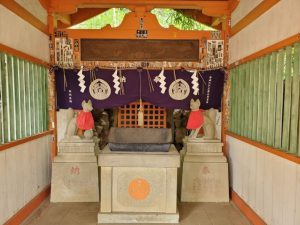
It was a welcome, relaxing experience after two weeks of the high energy and urgency of Minato City, and I very much want to return and continue exploring the winding streets and alleys of Yanaka Town.
